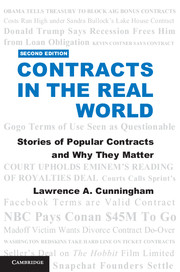Book contents
- Frontmatter
- Dedication
- Contents
- Annotated Contents
- Acknowledgments
- Introduction
- 1 Getting In: Contract Formation
- 2 Facing Limits: Unenforceable Bargains
- 3 Getting Out: Excuses and Termination
- 4 Paying Up: Remedies
- 5 Rewinding: Restitution and Unjust Enrichment
- 6 Writing It Down: Interpretation, Parol, Frauds
- 7 Performing: Duties, Modifi cation, Good Faith
- 8 Hedging: Conditions
- 9 Considering Others: Third Parties and Society
- Conclusion
- Appendix A Offering and Accepting
- Appendix B Buying and Selling Goods
- Notes
- Table of Cases
- Index
1 - Getting In: Contract Formation
Published online by Cambridge University Press: 05 March 2016
- Frontmatter
- Dedication
- Contents
- Annotated Contents
- Acknowledgments
- Introduction
- 1 Getting In: Contract Formation
- 2 Facing Limits: Unenforceable Bargains
- 3 Getting Out: Excuses and Termination
- 4 Paying Up: Remedies
- 5 Rewinding: Restitution and Unjust Enrichment
- 6 Writing It Down: Interpretation, Parol, Frauds
- 7 Performing: Duties, Modifi cation, Good Faith
- 8 Hedging: Conditions
- 9 Considering Others: Third Parties and Society
- Conclusion
- Appendix A Offering and Accepting
- Appendix B Buying and Selling Goods
- Notes
- Table of Cases
- Index
Summary
The great variety of contract theories since the Romans attests to the fact that the power of making promises has occupied the center of political thought over the centuries.
– Hannah ArendtHandshakes and Feuds from Snapchat to Facebook
In 2011, Frank Reginald “Reggie” Brown, IV was an English major at Stanford University, living in the Kimball Hall dormitory. There Brown conceived of an idea for a mobile device application that would let people send pictures from one phone to another, but with a novel catch: the picture would self-destruct shortly after viewing, so the recipient could not save or forward it. The idea would become the lucrative Snapchat product, at one point valued at $15 billion (an astounding expression of investor optimism about the future considering that customers do not pay for the service and a way to make profits had not yet been devised). But Brown, having failed to formalize a contract, had to fight for his share of the value.
As spring blossomed in Palo Alto that year, Brown was hanging out in the dorm room of a friend, Thomas Spiegel, when he explained the app. Spiegel called it a “million-dollar idea.” After Spiegel asked Brown if they could work on it together, Brown said yes, and the two shook hands. That night they began searching for a computer coder to help. After interviewing several candidates, they chose Robert Cornelius Murphy. Another Stanford student and friend of Spiegel's, the three were all also Kappa Sigma fraternity brothers.
The trio then agreed orally to develop the app – which Brown initially called “Picaboo,” after the children's game – and split profits among them equally. Control and management would likewise be shared, and each would have specific roles: Spiegel, chief executive officer; Brown, chief marketing officer; and Murphy, chief technology officer.
By early summer, the three were deep into the venture. They decamped to work and live together on the start-up at the home of Spiegel's father, on Toyopa Street in Los Angeles, which Spiegel called the “start-up house.” Brown wrote the terms of use, designed the product logo (a cartoonish smiling ghost), and the promotional pages for social media sites. The three jointly designed the app's features, including the camera button, screen layout, and colors.
Information
- Type
- Chapter
- Information
- Contracts in the Real WorldStories of Popular Contracts and Why They Matter, pp. 11 - 48Publisher: Cambridge University PressPrint publication year: 2016
